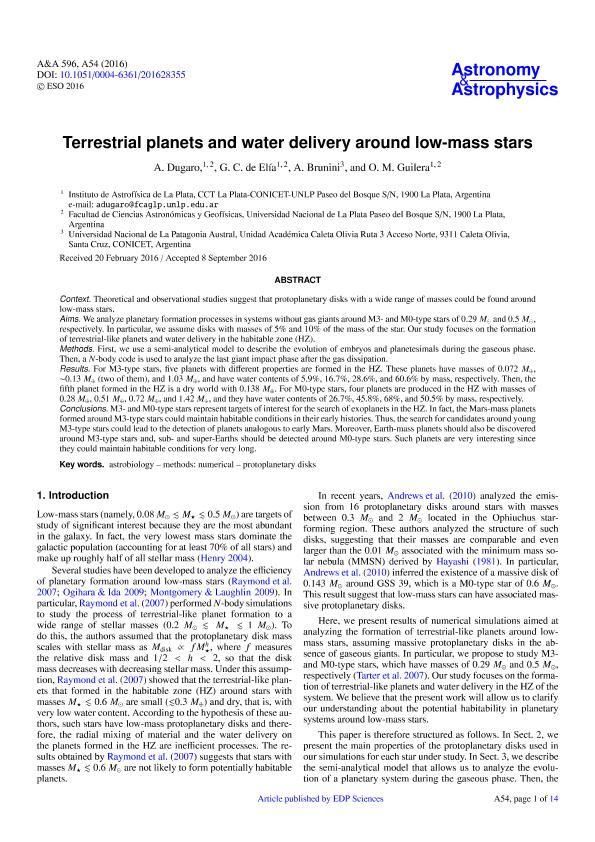Mostrar el registro sencillo del ítem
dc.contributor.author
Dugaro, Agustin

dc.contributor.author
de Elia, Gonzalo Carlos

dc.contributor.author
Brunini, Adrian

dc.contributor.author
Guilera, Octavio Miguel

dc.date.available
2018-02-19T16:14:33Z
dc.date.issued
2016-11
dc.identifier.citation
Dugaro, Agustin; de Elia, Gonzalo Carlos; Brunini, Adrian; Guilera, Octavio Miguel; Terrestrial planets and water delivery around low-mass stars; EDP Sciences; Astronomy and Astrophysics; 596; A54; 11-2016; 1-14
dc.identifier.issn
0004-6361
dc.identifier.uri
http://hdl.handle.net/11336/36716
dc.description.abstract
Context. Theoretical and observational studies suggest that protoplanetary disks with a wide range of masses could be found around low-mass stars. Aims: We analyze planetary formation processes in systems without gas giants around M3- and M0-type stars of 0.29 M⊙ and 0.5 M⊙, respectively. In particular, we assume disks with masses of 5% and 10% of the mass of the star. Our study focuses on the formation of terrestrial-like planets and water delivery in the habitable zone (HZ). Methods: First, we use a semi-analytical model to describe the evolution of embryos and planetesimals during the gaseous phase. Then, a N-body code is used to analyze the last giant impact phase after the gas dissipation. Results: For M3-type stars, five planets with different properties are formed in the HZ. These planets have masses of 0.072 M⊕, 0.13 M⊕ (two of them), and 1.03 M⊕, and have water contents of 5.9%, 16.7%, 28.6%, and 60.6% by mass, respectively. Then, the fifth planet formed in the HZ is a dry world with 0.138 M⊕. For M0-type stars, four planets are produced in the HZ with masses of 0.28 M⊕, 0.51 M⊕, 0.72 M⊕, and 1.42 M⊕, and they have water contents of 26.7%, 45.8%, 68%, and 50.5% by mass, respectively. Conclusions: M3- and M0-type stars represent targets of interest for the search of exoplanets in the HZ. In fact, the Mars-mass planets formed around M3-type stars could maintain habitable conditions in their early histories. Thus, the search for candidates around young M3-type stars could lead to the detection of planets analogous to early Mars. Moreover, Earth-mass planets should also be discovered around M3-type stars and, sub- and super-Earths should be detected around M0-type stars. Such planets are very interesting since they could maintain habitable conditions for very long.
dc.format
application/pdf
dc.language.iso
eng
dc.publisher
EDP Sciences

dc.rights
info:eu-repo/semantics/openAccess
dc.rights.uri
https://creativecommons.org/licenses/by-nc-sa/2.5/ar/
dc.subject
Astrobiology
dc.subject
Numerical Methods
dc.subject
Protoplanetary Disks
dc.title
Terrestrial planets and water delivery around low-mass stars
dc.type
info:eu-repo/semantics/article
dc.type
info:ar-repo/semantics/artículo
dc.type
info:eu-repo/semantics/publishedVersion
dc.date.updated
2018-02-07T17:03:38Z
dc.journal.volume
596
dc.journal.number
A54
dc.journal.pagination
1-14
dc.journal.pais
Francia

dc.journal.ciudad
Paris
dc.description.fil
Fil: Dugaro, Agustin. Universidad Nacional de la Plata. Facultad de Ciencias Astronómicas y Geofísicas; Argentina. Consejo Nacional de Investigaciones Científicas y Técnicas. Centro Científico Tecnológico Conicet - La Plata. Instituto de Astrofísica La Plata. Universidad Nacional de La Plata. Facultad de Ciencias Astronómicas y Geofísicas. Instituto de Astrofísica la Plata; Argentina
dc.description.fil
Fil: de Elia, Gonzalo Carlos. Universidad Nacional de la Plata. Facultad de Ciencias Astronómicas y Geofísicas; Argentina. Consejo Nacional de Investigaciones Científicas y Técnicas. Centro Científico Tecnológico Conicet - La Plata. Instituto de Astrofísica La Plata. Universidad Nacional de La Plata. Facultad de Ciencias Astronómicas y Geofísicas. Instituto de Astrofísica la Plata; Argentina
dc.description.fil
Fil: Brunini, Adrian. Universidad Nacional de la Patagonia Austral. Unidad Academica Caleta Olivia; Argentina
dc.description.fil
Fil: Guilera, Octavio Miguel. Consejo Nacional de Investigaciones Científicas y Técnicas. Centro Científico Tecnológico Conicet - La Plata. Instituto de Astrofísica La Plata. Universidad Nacional de La Plata. Facultad de Ciencias Astronómicas y Geofísicas. Instituto de Astrofísica la Plata; Argentina. Universidad Nacional de la Plata. Facultad de Ciencias Astronómicas y Geofísicas; Argentina
dc.journal.title
Astronomy and Astrophysics

dc.relation.alternativeid
info:eu-repo/semantics/altIdentifier/url/http://adsabs.harvard.edu/abs/2016A%26A...596A..54D
dc.relation.alternativeid
info:eu-repo/semantics/altIdentifier/doi/http://dx.doi.org/10.1051/0004-6361/201628355
Archivos asociados
